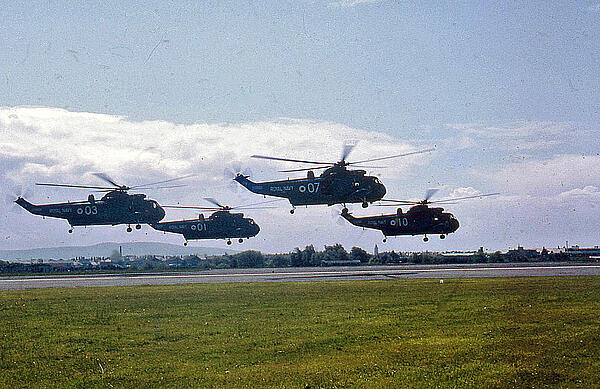The Sea King helicopter
The Sea King helicopter carried out a number of key roles during the Falklands War, including being a troop carrier and equipment mover. It was also used to deliver and extract Special Forces troops onto the Falklands Islands.
Named as one of the major air defence elements of the Falklands War, the Sea King helicopter was relied upon by troops for insertion and extraction of men to and from the islands, moving of equipment and also for anti-submarine activities.
May 1969 saw the first Sea King helicopter take to the skies and it was enlisted by the Royal Navy later the same year. The design of the craft has been honed over the year and a range of functions have been added to boost its reliability and effectiveness. Named as being of vital importance to the Falklands War effort, the helicopter fulfilled its eclectic mix of roles perfectly. Just four of the helicopters were lost over the course of the conflict – one was burned by its crew in Chile and three were lost to malfunctions – two of these incidents saw all crew members saved.

However, the third Sea King that was lost due to malfunctions crashed into the sea on 19 May 1982, killing 22 men from the Special Air Service, including 18 SAS men. The craft had been attempting to land upon the ‘Fearless’ when the accident happened. It was rumoured at the time of the incident that a large sea bird had flown into the helicopter’s rotor blades, causing it to ditch into the sea. However, this theory has since been disputed, with claims that the helicopter itself suffered a major malfunction and no external factors were involved. This tragedy saw the SAS endure the largest number of lives lost on a single day since World War II.
Each Sea King helicopter was able to transport 27 passengers a total distance of 764 miles, running at a top speed of 145mph and a maximum height of 10,000 feet. These crafts were involved in the successful attack on the Pebble Island Argentine air base on the 14th and 15th May. The helicopters usually have a two-man crew, but can take a crew of four.
One of the men on board the Sea King described it as a tight fit when everyone was in their combat gear, saying:
“Now the textbook says that the Sea King has a voluminous fuselage and so it does if the team is wearing just t-shirts and shorts. But here we were tooled up for the raid with bergens, webbing and weapons, which meant there was f*** all room for any of us. I wedged myself in the corner and waited for what seemed like an eternity before we lifted off.”
In terms of development of the Sea Kings, an Early Airborne Warning version of the Sea King was created in 1985, just that bit too late to be used in the Falklands conflict. It has been noted that, if this version of the helicopter had been available to be used in the Falklands War, the loss of ships as a result of long range Exocet strikes may well have been lessened. Today, the Merlin helicopter is taking over the role once played by the Sea King – described as a real military workhorse – but the Royal Marines are still utilising the HC Mk 4.
See also: The Lynx helicopter
MLA Citation/Reference
"The Sea King helicopter". HistoryLearning.com. 2025. Web.
